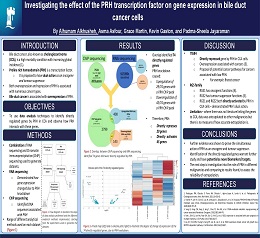Scholars World Congress on
Cancer Research and Oncology
THEME: "Frontiers in Cancer Research and Oncology"
 14-15 Nov 2022
14-15 Nov 2022  TIME Asma Hotel, Albarsha | Dubai, UAE & Online (Hybrid event)
TIME Asma Hotel, Albarsha | Dubai, UAE & Online (Hybrid event) THEME: "Frontiers in Cancer Research and Oncology"
 14-15 Nov 2022
14-15 Nov 2022  TIME Asma Hotel, Albarsha | Dubai, UAE & Online (Hybrid event)
TIME Asma Hotel, Albarsha | Dubai, UAE & Online (Hybrid event) 
University of Nottingham
Investigating the effect of the PRH transcription factor on gene expression in bile duct cancer cells
Background:
The proline rich homeodomain (PRH) protein is one of the few discovered
proteins that cannot be classified exclusively as an oncogene or a tumour
suppressor. It is proposed to have dual tumour suppressive and oncogenic
action, dependent on location and condition. Both overexpression and
downregulation of PRH have led to increases in malignancy. Bile duct cancer,
also known as cholangiocarcinoma (CCA), is an example of overexpression of PRH
acting in an oncogenic manner.
Objectives:
The primary aim of the study was to use data analysis techniques to identify
directly regulated genes by PRH in CCA and observe how PRH interacts with these
genes.
Methods:
A variety of data analytical methods were implemented on RNA sequencing and
chromatin immunoprecipitation (ChIP) sequencing datasets, obtained from
experiments on a human CCA cell line (CCLP1). The overlap between both datasets
determined which genes are directly regulated by PRH.
Results:
A set of 74 genes, directly regulated by PRH, was curated. Of
these, 6 repeatedly emerged in Gene Set Enrichment Analysis (GSEA) results,
revealing enrichment in multiple different signature gene sets. These 6 genes were
investigated and discussed: Integrin Beta 4 subunit (ITGB4), Krupper Like
Factor 5 (KLF5), SRY-Box Transcription Factor 9 (SOX9), GATA binding protein 3
(GATA3), Regulator of G Protein Signalling 1 (RGS1) and Regulator of G Protein
Signalling 2 (RGS2).
Conclusions: Further
evidence was shown to prove the simultaneous action of PRH as an oncogene and
tumour suppressor, whilst proposing several new links between PRH and these
genes, unbeknownst to current literature. The identification of the genes
discussed warrants further investigation and exploration into their potential
as novel biomarkers or therapeutic targets in CCA.